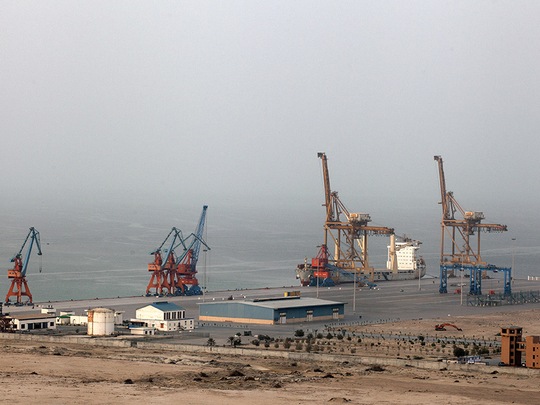
Ashfaq Ahmed |
The $56 billion China Pakistan Economic Corridor (CPEC) is one of the most important parts of the China’s One Belt One Road (OBOR) initiative for a stronger trade connectivity in the world.
OBOR is China’s ambitious project to revive the ancient Silk route for trade connecting China, Central Asia and Europe by developing three main corridors via southern, northern and central Xinjiang, which links China with Pakistan, Russia, India and Europe.
The mega investment project that connects Pakistan with China is called CPEC — and it is the most significant part of the "One Belt, One Road" initiative.
China has made commitments to invest around $56 billion (Dh205.5 billion) in CPEC involving development deals, which is equivalent to roughly 20 per cent of Pakistan’s annual GDP.
CPEC is believed to be China’s biggest ever investment overseas to build a 3,218km route by 2030, consisting of highways, railways and pipelines that will connect Pakistan’s Gwadar Port to Xinjiang province of China.
In total, the economic corridor project aims to add some 17,000 megawatts of electricity generation at a cost of around $34 billion. The rest of the money will be spent on transport infrastructure, including upgrading the railway line between the port of Karachi and the northwest city of Peshawar.
Key corridor
Development of Gwadar port, which would provide Beijing a firm and long-term foothold in the Indian Ocean, is an important part of the CPEC as this economic corridor will behave as a channel for the novel Maritime Silk Route that imagines connecting three billion people in Asia, Africa and Europe.
CPEC aims to revive the earliest Silk Road with an emphasis on infrastructure, and establishes the strategic structure of bilateral cooperation.
The project associates China’s strategy to improve its western constituencies with Pakistan’s concentration on enhancing its economy, comprising the infrastructure construction of Gwadar Port.
However, Pakistan will benefit more from CPEC. China has become the second largest trade partner of Pakistan and biggest investor in infrastructure, telecommunications, ports, energy sectors.
Furthermore, Chinese government and private companies from China have guaranteed to spend $20 billion in the energy sector and massive amount of above $30 billion in other sectors as a foreign direct investment in Pakistan, which will help promote trade between the two countries.
The recent development in Pakistan-China corridor makes Pakistan the first transit hub for the world’s second largest economy among South Asian countries.
Irrespective of the political and military consequences of this project, it has numerous benefits for the people of the constituency.
Pakistan, which suffers from continuous energy shortages and low trade with its neighbours, will be better-linked and will have sufficient energy.
From East to West
A Pakistan-aligned road network will enable contacts among its neighbours in the west and east. India and Iran require this corridor for closer cooperation with each other’s economy.
Even though the CPEC simplifies movement of goods and services in the region, China’s contribution in the region’s economy turns rivals into stakeholders in preserving peace and stability in the region.
The CPEC is not only a game-changer in the region but will also be a ‘fate-changer’ for the people of Pakistan.The CPEC will serve as a gateway for trade not only for China and Pakistan, but for the whole region.
Connectivity
Better connectivity in the region will improve trade among Pakistan, China, Iran, India, Afghanistan and the Central Asian Republics.
Pakistan envisages the CPEC as a peace enabler because when connectivity and trade increases between countries, they tend to avoid conflicts. Through CPEC, Pakistan’s Vision 2025 seeks to position itself from a lower middle income country to high middle income country by achieving the target per capita GDP of $4,200.
Through this project Pakistan will become the hub of business and trade in Asia, and western China will be able to penetrate Asian and European markets. It will cater to the needs of all federal units of Pakistan through proper rail and road network and multiple projects on energy within the next three years.
Pakistan is expected to be totally transformed this year. The CPEC also attracts foreign and local investors in the fields of high-capacity industrial units, factory–market road transportation and distribution services, rail-supported bulk transit of goods, dry ports along the CPEC routes, storage facilities for transit food and goods.
Pakistan and China are to soon conclude agreements for financing and construction of the Gwadar International Airport and East-Bay Expressway.
Impact on the job market
Nine economic zones have been identified to be set up in different parts of the country. Currently feasibility studies are being undertaken and financial agreements are expected to be concluded by the next Joint Cooperation Committee meeting later this year.
Based on the profile of workforce engaged on projects in progress, officials insist that over 80 per cent direct new jobs will be filled by locals in the initial years.
However, if the multiplier effect over the next 10 years is taken into account the ratio would be no less than 1: 150 i.e. for each Chinese national inducted in a job, 150 Pakistanis will be employed.
The best of all is that CPEC enjoys the support and backing of all political parties and segments of the establishment in Pakistan. Its popularity among the public is also set to grow when they will start benefiting from the project.
For Pakistan, it will release huge development dividends benefiting all aspects of people’s lives.










